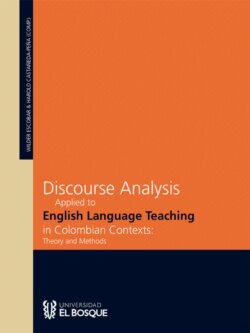Читать книгу Discourse analysis applied to english language teaching in colombian contexts: theory and methods - Wilder Yesid Escobar Alméciga - Страница 13
На сайте Литреса книга снята с продажи.
Summary and discussion
ОглавлениеThe main purpose of this chapter was to review how classroom language has been studied especially in the context of the teaching of foreign and/or second languages. In order to achieve this goal, I started presenting how classroom language is different from a typical conversation. That difference was argued using two criteria, which I called symmetry and level of formality. However, symmetry and level of formality do not fully differentiate classroom language and conversations. This happens because both classroom language and conversations are contingent and to a very large extent depend on context; it is this last feature that makes them differ. I also outlined two additional concepts: text and discourse. I will maintain for the purposes of my own research that classroom discourse is text-context situated and will not argue about differences between text linguistics and semantic linguistics, which at the end have the same units of analysis but are investigated from a rather different, abstract point of view.
Classroom language has been researched in the few past decades through different approaches. Table 3 summarizes my first attempt to map out a very succinct account of classroom discourse analysis. Table 3 has been organized chronologically, so the first column refers to the year the research or article was published. The name of the main researcher will be found in the second column. Column three has the type of article or book. There are different kinds of articles in this brief presentation of research about classroom discourse analysis. Some of them are either books or articles based on scientific research. By scientific research I mean that kind of investigation described in a report where it is easy to distinguish a research question and the attempt to answer it by following a rigorous process of validation or demonstration. Other articles are revision or reflection articles. The fourth column displays what has been called the tradition. Tradition in this context refers mainly to the discipline of origin from which the study derives; such discipline scaffolds the theoretical framework supporting the study and the approach to the analysis of results. The fifth column describes whether or not the study approaches the research question from a quantitative or a qualitative point of view or even from a complementary analysis between these two options. This column will also point out whether or not the study simply presents a theoretical explanation of specific phenomena. Columns number 6 and 7, when applicable, present the research participants and the level on which the research was conducted. Finally, the two last columns highlight the major theoretical contributions and summarize the main findings for each study. Some of the works outlined in this review do not clearly present theoretical contributions or conceptual variations in the sense that there is no theory construction; rather, these are used to present what has been already established in the discipline of origin.
Table 3. Brief Relation of Classroom Discourse Models in General Educational Contexts.
